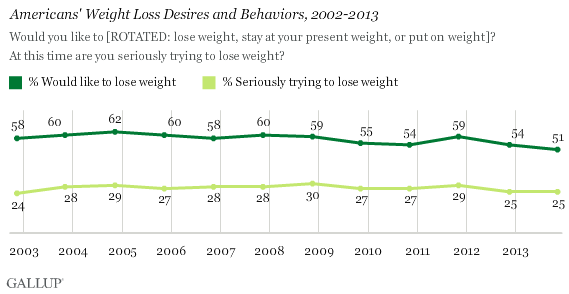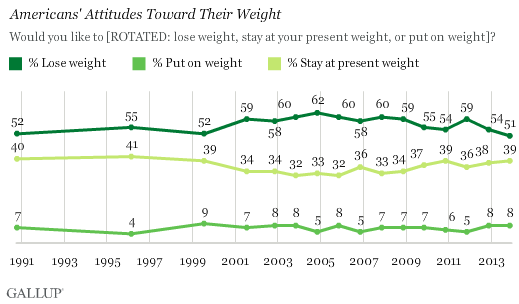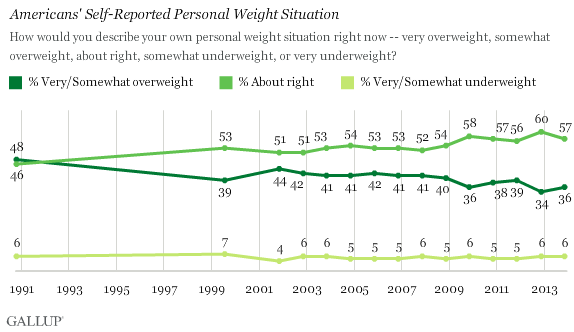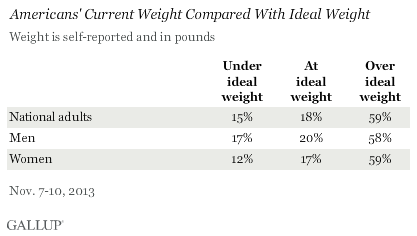Well, it's the holidays and the time of year we all say we need to watch our waistlines. But, then the New Year hits and it's back to the gym, making resolutions, and promising next year we won't go overboard on all the holiday goodies.
Well, read below to see if your perception of your weight is sabotaging your efforts!!
WASHINGTON, D.C. -- Americans' desire to lose weight does not necessarily translate into their doing anything to achieve it. While 51% of adults want to lose weight, barely half as many (25%) say they are seriously working toward that goal. This discrepancy between Americans' weight-loss desires and behavior
has existed for years.
The current 26-percentage-point gap between those who want to lose weight and those who are actively trying to do so is slightly narrower than the gap found in most years since 2002. The percentage saying they would like to lose weight has dropped eight points since 2011. At the same time, the percentage trying to lose weight has dropped four points.
These results are based on Gallup's annual Health and Healthcare survey, conducted Nov. 7-10 this year. Gallup has asked Americans to report their attitudes toward their weight and their current weight situation yearly since 2002 and occasionally before then.
Americans' desire to lose weight has not kept up with the rise in adults' self-reported weight over the past 23 years. Americans report weighing an average of 15 pounds more now than in 1990, but the percentage who want to lose weight is the same now as it was then.
Women (57%) are more likely than men (46%) to say they want to lose weight, consistent with what Gallup has found historically. But the gender gap is smaller in the percentages who are making an effort: 27% of women vs. 22% of men.
More Than One-Third of Americans Classify Themselves as Overweight
More Americans want to lose weight than actually see themselves as overweight. Overall, 36% describe themselves as overweight, on par with 34% in 2012, but down slightly from most years since 2002 and from 1990. This includes 34% of men and 39% of women who say they are overweight.
Americans are much more likely to say their weight is "about right" than to say they are "overweight." It is possible that that some adults are reluctant to label themselves as overweight or lean toward saying they are "about right" if they are only a few pounds overweight.
The Nov. 7-10 poll also asked Americans to state their ideal weight. Nearly six in 10 Americans are heavier than their ideal weight by at least one pound, while fewer than two in 10 are at their ideal weight. This suggests that adults are much more likely to know they are heavier than their ideal weight than to classify themselves as overweight.
Americans' self-reported actual weight is 176 lbs. and their ideal weight is 161 lbs., for a difference of 15 lbs. -- on par with the average difference of 16 lbs. since 2002.
Women, on average, weigh 157 lbs., but would like to weigh 139 lbs. Men tip the scale at 195 lbs., on average, but would like to weigh 182 lbs. The difference between the actual and ideal weight is larger among women than among men, 18 lbs. vs. 13 lbs., as has been the case historically. Women may face more societal pressure than men to have a lower ideal weight, or may have more weight to lose.
Implications
Another explanation may be that some Americans realize they are overweight, but only by a few pounds. Consequently, they may not see it as a major issue that requires corrective action. Employers can assume an important role in educating workers about strategies to achieve and maintain a healthy weight.
Losses in productivity attributable to workers' being above a normal weight or having chronic conditions are substantial, so employers that focus on their workers' physical well-being could reap the double benefit of a healthier workforce and cost savings.
While most Americans, particularly those who say they are overweight, say their
doctor usually discusses the benefits of healthy habits with them, physicians may need to be more direct in their conversations with patients about reaching a healthy weight. The American Medical Association classified obesity as a disease earlier this year, which may prompt more physicians to speak with patients about their weight.
Survey Methods
Results for this Gallup poll are based on telephone interviews conducted Nov. 7-10, 2013, with a random sample of 1,039 adults, aged 18 and older, living in all 50 U.S. states and the District of Columbia.
For results based on the total sample of national adults, the margin of sampling error is ±4 percentage points at the 95% confidence level.
For results based on the sample of 562 men, the margin of sampling error is ±5 percentage points at the 95% confidence level.
For results based on the sample of 477 women, the margin of sampling error is ±6 percentage points at the 95% confidence level.
Interviews are conducted with respondents on landline telephones and cellular phones, with interviews conducted in Spanish for respondents who are primarily Spanish-speaking. Each sample of national adults includes a minimum quota of 50% cellphone respondents and 50% landline respondents, with additional minimum quotas by region. Landline and cell telephone numbers are selected using random-digit-dial methods. Landline respondents are chosen at random within each household on the basis of which member had the most recent birthday.
Samples are weighted to correct for unequal selection probability, nonresponse, and double coverage of landline and cell users in the two sampling frames. They are also weighted to match the national demographics of gender, age, race, Hispanic ethnicity, education, region, population density, and phone status (cellphone only/landline only/both, and cellphone mostly). Demographic weighting targets are based on the March 2012 Current Population Survey figures for the aged 18 and older U.S. population. Phone status targets are based on the July-December 2011 National Health Interview Survey. Population density targets are based on the 2010 census. All reported margins of sampling error include the computed design effects for weighting.
In addition to sampling error, question wording and practical difficulties in conducting surveys can introduce error or bias into the findings of public opinion polls.
For more details on Gallup's polling methodology, visit
www.gallup.com.




